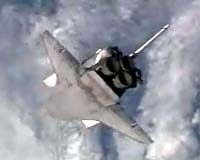 |
Washington (AFP) July 18, 2009 Two astronauts from the US space shuttle Endeavour ventured out on Saturday for the first of five planned spacewalks aimed at completing a Japanese laboratory at the International Space Station. Tim Kopra, who was making his first space walk, and Dave Wolf, an old hand with four walks under his belt, emerged from the decompression chamber of the International Space Station (ISS) at 1619 GMT, 20 minutes later than scheduled, NASA television said. They were set to prepare the installation of a third and final piece of the Japanese Kibo lab, brought up in the Endeavour's cargo bay. The 1.9-tonne porch-like section is to be used for experiments in the vacuum of space will be attached to Kibo's two pressurized modules that were delivered to the ISS last year. Once the pieces are ready the astronauts inside will maneuver Endeavour's robotic arms to put the section in place. Saturday's space walk was expected to take over six hours. Earlier on their first full day in space, the Endeavour crew inspected the spacesuits they will use in the five spacewalks planned during the mission. The crew of six Americans and one Canadian also tested rendezvous equipment, installed a camera for the orbiter docking system and extended the docking ring that sits on top of the system. The Endeavour mission aims to help fulfill "Japan's hope for an out-of-this-world space laboratory," as the shuttle delivers state-of-the-art equipment to conduct experiments in the vacuum of space, according to NASA. Wolf and Kopra spent the night in the Quest airlock to reduce the preparation time needed for the walk. On Friday the shuttle successfully docked at the space station amid questions about the integrity of the shuttle's heat shield. During the delicate docking maneuver the two space vehicles traveled at 28,000 kilometers (17,398 miles) per hour as they approached each other, giving Commander Mark Polansky a margin of error of 4.5 centimeters (1.8 inches) to complete the procedure, NASA said. The entry of Endeavour's crew aboard the ISS brought the number of astronauts inside the orbiting space station to a record 13. Kopra will be staying aboard the ISS, taking over from Japanese engineer Koichi Wakata, who has been in space for 124 days. The ISS should be completed in 2010, also the target date for the retirement of the US fleet of three space shuttles.
earlier related report During their first full day in space, the Endeavour crew inspected the spacesuits that they will use in the five spacewalks planned during the mission. The seven-person crew, including six Americans and one Canadian also tested rendezvous equipment, installed a camera for the orbiter docking system and extended the docking ring that sits on top of the system. The Endeavour mission aims to help fulfill "Japan's hope for an out-of-this-world space laboratory," as the shuttle delivers state-of-the-art equipment to conduct experiments in the vacuum of space, according to NASA. Earlier Friday the shuttle successfully docked at the space station amid questions about the integrity of the shuttle's heat shield. During the delicate docking maneuver the two space vehicles traveled at 28,000 kilometers (17,398 miles) per hour as they approached each other, giving Commander Mark Polansky a margin of error of 4.5 centimeters (1.8 inches) to complete the procedure, NASA said. The entry of Endeavour's crew aboard the ISS brought the number of astronauts inside the orbiting space station to a record 13. As the shuttle approached the ISS, Polansky photographed the underside of the Endeavour to discover whether Wednesday's takeoff caused any damage to the shuttle's heat shield. During the launch, which came after five failed take-off attempts since June 13, debris could be seen peeling away from the shuttle external rocket booster and then striking the spacecraft. Endeavour astronauts used the shuttle's robotic arm for what the space agency called "the standard flight day two inspection" of the reinforced carbon nose cap and the wing's leading edge. Imagery experts on the ground will continue to scrutinize images transmitted by the astronauts to determine the state of the shuttle's thermal protection system, NASA said. The US space agency has been cautious about conditions for the shuttle's exit and return since the Columbia craft blew apart some 20,000 meters (65,500 feet) above the Earth in 2003 as it was returning from a 16-day space mission to land in Florida. A chunk of insulation that broke off from Columbia's external fuel tank during takeoff had gouged the space shuttle's heat shield, allowing superheated gases to melt the shuttle's internal structure before it exploded, killing all seven astronauts onboard. Share This Article With Planet Earth
Related Links Shuttle at NASA Watch NASA TV via Space.TV Space Shuttle News at Space-Travel.Com
 Endeavour astronauts to inspect heat shield
Endeavour astronauts to inspect heat shieldCape Canaveral, Florida (AFP) July 16, 2009 Astronauts aboard the US space shuttle Endeavour prepared on Thursday to inspect the heat shield for damage caused by debris that peeled off the external fuel tank during liftoff. The debris was spotted after the shuttle blasted off Wednesday from the Kennedy Space Center, its sixth bid in recent weeks to reach the International Space Station after delays caused by weather woes and technical ... read more |
|
| The content herein, unless otherwise known to be public domain, are Copyright 1995-2009 - SpaceDaily. AFP and UPI Wire Stories are copyright Agence France-Presse and United Press International. ESA Portal Reports are copyright European Space Agency. All NASA sourced material is public domain. Additional copyrights may apply in whole or part to other bona fide parties. Advertising does not imply endorsement,agreement or approval of any opinions, statements or information provided by SpaceDaily on any Web page published or hosted by SpaceDaily. Privacy Statement |